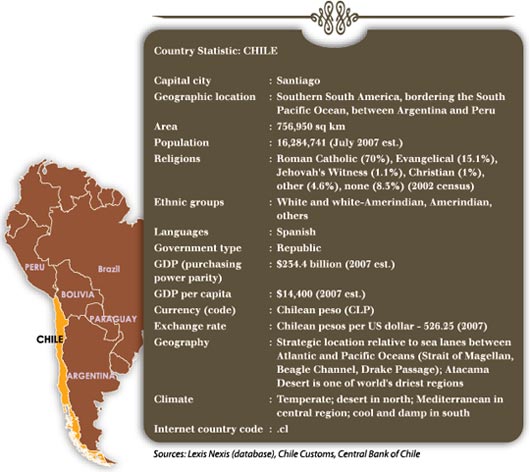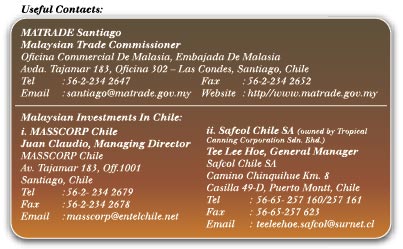From The MATRADE Desk: Chile: An Emerging Market In The Southern Cone
 Trade & Economy
Trade & Economy
 Chile has an open but very competitive market. Its exports primarily include resource-based goods: mining products, mainly copper and derivatives account for 59% of merchandise exports and agricultural goods for about 28%. Chile’s export partners are: USA, North East Asia, Latin American countries and the EU. Imports include a wide range of manufactured goods and petroleum. Chile’s import partners are countries within Latin America, USA, the EU and North East Asia.
Chile has an open but very competitive market. Its exports primarily include resource-based goods: mining products, mainly copper and derivatives account for 59% of merchandise exports and agricultural goods for about 28%. Chile’s export partners are: USA, North East Asia, Latin American countries and the EU. Imports include a wide range of manufactured goods and petroleum. Chile’s import partners are countries within Latin America, USA, the EU and North East Asia.
In 2007, Chile’s economy grew 5% while internal demand and private consumption increased 7.3% and 7.7%, respectively. Its exports rose 17.5% to US$68.3 billion and imports appreciated 22.1% to US$43.8 billion in 2007. FDI was recorded at US$15.3 billion. For 2008, Chile is forecasted to register GDP between 4.6% and 4.8% with inflation projected at 3.6%. Recently, the Central Bank of Chile announced the move to raise the interest rate from 6.0% to 6.25% to combat the inflation rate and reduce money circulation in the market. Trade plays an important role in Chile’s economy. The share of goods and services in Chile’s GDP increased to over 50% in 2007. Chile’s trade relations are focused on the negotiation of bilateral and free trade agreements and liberalisation initiatives. Tariff reductions under preferential agreements have contributed to improved access to the Chilean market for partners where duty free access or an average of 3% duty is offered to most imports.
International Trade Agreements
ETA or EPA frameworks have been the main selling point to attract foreigners to establish their presence here. It also helps local companies and industries meet import requirements more competitively and support business expansions. Currently, Chile has 18 trade agreements with 56 countries, accounting for about 85% of its trade, which also provides market access to over 2.4 billion people. Chile has preferential trade agreements with Mexico, Ecuador, Bolivia and Peru, CAFTA (Costa Rica, El Salvador, Nicaragua, Guatemala, Honduras), Canada, the EU and European Free Trade Association (EFTA), US, South Korea, Singapore, New Zealand and Brunei, China, Japan, Colombia and Panama. New trade agreements that open markets in Asia are the country’s top priority, especially in Asia Pacific countries like Malaysia, India, Australia and Vietnam.
Chile-Malaysia Trade Relations
Chile is Malaysia’s third important trading partner, third largest export destination and third biggest import source in South America. In 2007, bilateral trade between Malaysia and Chile totalled US$242.7 million with exports amounted to US$169.7 million and imports valued at US$73 million. Major Malaysian exports were electrical & electronics (64%), furniture (10%), rubber gloves (6%) and palm oil (2.4%). Imports from Chile were iron ores & concentrates, chemical wood pulp, frozen fish, fillet and caviar, seafood, fruits and wines, collectively accounting for 91.6% share. The trade balance has been in favour of Malaysia for the last three years and a hefty surplus of US$96.7 million was registered in 2007. To further strengthen trade and economic relations, Malaysia and Chile is negotiating for a Malaysia-Chile ETA. This will allow both countries to tap on the opportunities arising from their respective ETA arrangements.

A Burgeoning Retail Sector
Chile’s low unemployment rate has resulted in a larger consumer base with better purchasing power and an improved standard of living. The Government of Chile recently granted a 6% salary increase for its civil servants while the minimum salary for blue-collar workers was revised from US$240 to US$270. Consumers now have an increased buying ability which also accounts for an escalated demand for imported and branded products. The retail sector accounts for 20% of Chile’s total GDF? Registering the biggest growth among Latin American retail sectors, the Chilean retail sector’s foreign investments last year totalled US$535 million (34% of total invested abroad by Chilean companies).
Major retail stores in Chile prefer importing products directly because of the depreciation of the US dollar. Import goods are now more attractive as the exchange rate stands at 1US$=CP$460. To remain competitive, Chilean retail stores and supermarkets are also looking to secure better prices for a variety of products from reliable manufactures or suppliers. This provides many export opportunities for Malaysian companies. As the volumes demanded are big, suppliers must have a good track record, sufficient supply capacity and be prepared to provide favourable business terms and conditions. Chilean retails stores are moving towards the production of in-house brands and private labels. To meet local market demand, products like electrical appliances and white goods are sourced from abroad. Malaysian companies can bid for contract manufacturing or secure partnerships through joint venture and franchising.
 Zofri Free Trade Zone
Zofri Free Trade Zone
Products coming into Zofri, which is located in Northern Chile, are exempted from import duty. Other than warehousing, there are facilities available for bulk breaking and value-adding activities. At present, there are over 1,600 companies operating in Zofri, representing a wide range of industrial and consumer products. Among the international operators are Kia Motors, Philips and Sony. Foreign products entering Zofri are offered
tariff concessions from Chile’s free trade and economic complementary agreements provided they meet local content requirements. Malaysian exporters may also use Zofri as a distribution channel for exporting to other South American countries. Large Malaysian companies may also consider establishing a Malaysian Mall similar to what China has done in Chile in order to enhance the positioning of its products in the market.
Pointers For Malaysian Exporters
Good pricing, an assortment of products, reliable quality and an adequacy of supply are strengths that Malaysia exporters should emphasise on. Attractive after sales service and technical support including warranty terms could be offered on an exclusive basis to local distributors. Malaysian companies should preferably have ISO, six-sigma and other international accreditation. Exporters must be able to consolidate shipment as the import volumes demanded by SMEs in Chile are small. Buyer credit facility of 60, 90 or 120 days and quantity discounts would be added advantages. Malaysian exporters need to be more aggressive and demonstrate flexibility and reliability plus a readiness to establish long term relationship vis-à-vis competitor suppliers in the marketplace. Malaysian products that have export potential are electrical & electronics, palm oil, furniture, rubber products, security products, garments, fabrics & yarns, building materials, toiletries, medical disposables & equipment, processed food, energy drinks & tropical beverages, auto parts & accessories, cars & motorcycles, household articles & decorative items, educational toys, mining equipment and portable generators.
Investment Opportunities
There are also opportunities to be tapped in the IT, construction/infrastructure development, mining, forestry, and energy/power sectors. The construction sector in Chile has been growing in the region of 7% per annum, so there will be an abundance of private construction projects that Malaysian companies can participate in. With the country facing an acute energy shortage due to a cut in the supply of natural gas from Bolivia and Argentina, foreigners are encouraged to propose and initiate projects related to alternative energy generation.

